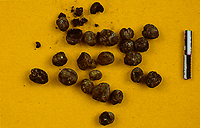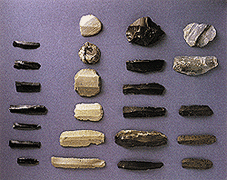 
According to charred flora remains discovered in Neolithic settlements and studied by palaeobotanologists, the development of agriculture in the Greek area took place during the 7th millenium BC and inaugurated, along with animal husbandry, the productive stage in the economy. There were three species of crops that were systematically cultivated from the Pre-Pottery Neolithic: einkorn and emmer wheat and barley. The study of charred grains from settlements in Macedonia, Thessaly, Argolid and Crete has shown that during the first phases of the Neolithic emmer wheat was more widespread, while at the same time pulses (lentils, peas) were also cultivated. From the Early Neolithic flax was also cultivated, which along with wool from sheep and goats, constituted a very important raw material for weaving. From the Late Neolithic, agriculture developed with the cultivation of bread wheat (Sitagroi, Sesklo), millet (Argissa, Chaironeia), rye (Tharrounia-Euboea) and oat (Platia Magoula Zarkou, Tharrounia). To pulses, broad beans were added (Sesklo, Dimini, Tharrounia), Vicia evilia and chick peas (Dimini), enriching thus the diet in vegetable proteins. It is doubtful whether medick, grass pea and bitter vetch, encountered in Neolithic settlements and today listed among fodder legumes, were part of the diet of the Neolithic farmer and stock-rearer. During the Late and Final Neolithic the cultivation of barley intensified, probably due to its adaptability to different climatic conditions. In the first phases of the Neolithic two-row barley was widely cultivated (Gentiki, Soufli, Nea Nikomedeia, Franchthi, Kea, Knossos), while from the Late Neolithic onwards six-row barley was preferred in Macedonia and Thessaly. |
|
The diet of Neolithic man was supplemented by fruit collected from plants in the immediate and surrounding environment of the settlements: acorns, pisstacchios, almonds, prunella, cherries, plums, apples, pears, olives, grapes and mulberries. The systematic cultivation of olive and vine began during the Bronze Age. |
 For agriculture, stretches of land around or at a relatively short distance
from the settlements were required. To secure them the clearance of stretchesof
maquis or similar areas was frequently carried out and has been recorded
as the first ecological intervention by Man! From the study of flora remains
it has been concluded that cereals and pulses were cultivated either in
the same or in different fields. Mixed cultivations have for example been
observed at Gentiki and Argissa, while in Prodromos and Sesklo cultivations
were carried out separately. Nevertheless, the species of cereals and
pulses mentioned were not cultivated in all the settlements of Greece.
In Nea Nikomedeia and Magoula Balomenou, for example, only one kind of
wheat was preferred. Fields were tilled with
For agriculture, stretches of land around or at a relatively short distance
from the settlements were required. To secure them the clearance of stretchesof
maquis or similar areas was frequently carried out and has been recorded
as the first ecological intervention by Man! From the study of flora remains
it has been concluded that cereals and pulses were cultivated either in
the same or in different fields. Mixed cultivations have for example been
observed at Gentiki and Argissa, while in Prodromos and Sesklo cultivations
were carried out separately. Nevertheless, the species of cereals and
pulses mentioned were not cultivated in all the settlements of Greece.
In Nea Nikomedeia and Magoula Balomenou, for example, only one kind of
wheat was preferred. Fields were tilled with